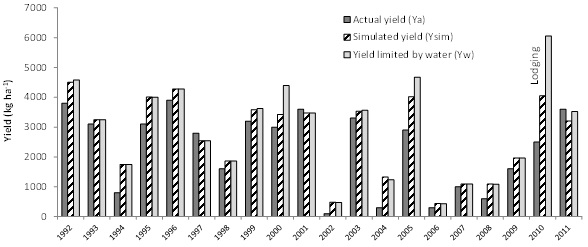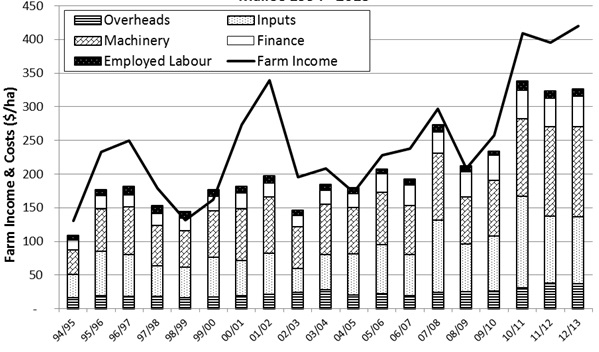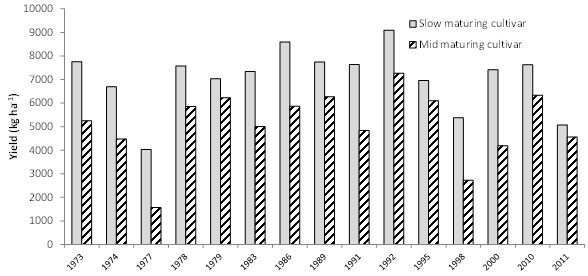Leading farmers have closed the yield gap – what are the implications for productivity growth?
Leading farmers have closed the yield gap – what are the implications for productivity growth?
Author: Harm van Rees, Tim McClelland and Zvi Hochman | Date: 17 Feb 2015
Harm van Rees1 2, Tim McClelland2 and Zvi Hochman3, 1Cropfacts P/L; 2Birchip Cropping Group; 3CSIRO Agriculture Flagship.
Keywords: yield gap, actual yield, potential yield, productivity, simulation, APSIM, Yield Prophet®, risk, costs.
Take home messages
- Leading farmers and their advisers have responded to the need for increased productivity by pioneering and adapting new technologies to narrow the exploitable yield gap between actual and potential yield.
- As productivity increased, the cost of production also rose significantly over the last decade. Further increases in costs are unlikely to be economically sustainable.
- Farmers require technological breakthroughs to sustainably push the production frontier to new and higher levels. One such breakthrough could be planting long-season wheat cultivars in seasons with stored soil water and rain during early planting.
- A better understanding of the cost of production and financial risk management is essential for farming businesses to prosper into the future. Farmers and their advisers need to understand the drivers of profitability in the business, and how the business compares with others in the industry. An important criterion of risk is the relationship between losses in poor years versus profits in good years.
- Crop planning budgets should be developed on actual yield (last 10 years) rather than long term averages.
- Understanding climate risk and how to manage the vagaries of the weather with rotation/crop choice, sowing opportunities (frost and heat shock), and inputs (in particular N) need to be better managed by using tools such as Yield Prophet®.
- Simulation modelling can assist in investigating strategic and tactical management options to increase yield and manage risk.
What are the issues?
- Have leading farmers closed the yield gap (difference between actual and potential yield)?
- Have the costs of production risen and are profit margins declining?
- Where are the next productivity gains coming from?
- How can we improve risk management in a variable climate?
- How can farmers increase margins?
Introduction
Leading grain farmers, with support from their agronomists, have initiated and participated in the rapid development and adoption of new and improved crop management practices over the last 20 to 30 years. Agronomic research supported by GRDC, government and the private sector has resulted in identifying and overcoming key constraints to production. Farmers have made significant changes to production systems, leaving behind traditional farming practices. No-till farming, where crops are sown into standing stubble from the previous crop, is now normal practice. Improved crop breeding programs and farmers rotating sequences of cereals, oilseeds and pulses, have reduced disease levels and broadened herbicide options resulting in improved weed control. Nutrient supply and timing of operations have improved markedly. Decision support tools such as Yield Prophet® have helped improve understanding of crop development and decision making, matching inputs to variable climatic conditions.
Many farmers and agronomists had hoped that production gains were increasing faster than the rising costs of production, but the new management practices have come at a high price. It appears that we are now entering a phase of diminishing returns where increased inputs do not necessarily lead to more profit. Leading farmers in south eastern Australia are concerned that their crop yields have reached a plateau and are asking the question ‘Where are the next production and profitability gains coming from?’ (van Rees et al. 2014).
Methods
The methodology to test whether leading farmers have reached a production plateau is based on long term paddock records (16 to 20 years) for three farms in north western Victoria. The farms are located in the Wimmera (self-mulching clays), Southern Mallee (sandy loams over sodic subsoils) and Eastern Mallee (clay loams over sodic subsoils). APSIM (Holzworth et al. 2014) was used to determine: (i) simulated yield, Ysim (simulated yield produced with the same inputs, cultivars, sowing date etc. as occurred in the paddock); and (ii) potential yield, Yw (water limited and nitrogen unlimited yield, i.e. simulated yield without N limitations). The yield gap between potential and actual yield was then calculated.
Long term financial records from twelve Victorian Mallee farms, provided by ORM Pty Ltd, have been used to demonstrate the changes in costs over time, and what impact the current cost structure has on reducing profitability.
Results
How good is APSIM in simulating crop production in NW Victoria?
Annual wheat paddock records for the three farms were used to initialise APSIM with pre-sowing soil available nitrogen (N) and water, cultivar sown, sowing date, N inputs and date of application. Simulated yields were compared with actual yield and are presented in Figure 1.

Figure 1. Simulated versus actual yield for three farms in NW Victoria, each with 16 to 20 years data. The squares indicate years with widespread frost, hail and flood damage. These years are not included in the regression.
The relationship between APSIM simulated (Ysim) and actual paddock yield (Ya) is very strong (r2=0.89) which increased our confidence in using it as a tool to simulate potential yield and also to use simulation to investigate alternative production practices. The small variation between Ysim and Ya also implies that these farmers have a good nutrient program and a high level of pest, weed and disease control.
What is the yield gap in our region?
For each farm the annual actual paddock yield (Ya) was compared with the potential yield (Yw, unlimited N) (Figure 2). For the southern Mallee farm the yield gap (difference between actual and potential yield) was 18 per cent (calculated as the difference between Yw and Ya, as a percentage of Yw). The average long term yield gap for the three farms was 21 per cent.

Figure 2. Actual paddock yield (Ya), simulated yield (Ysim same inputs as actual) and potential yield (Yw, unlimited N) for the southern Mallee farm (1992 to 2011).
Farm income and cost of production
Financial performance for 12 Victorian Mallee farms is presented in Figure 3. Costs have been allocated into the following groups: inputs; machinery; finance; overheads; and employed labour (owner drawings are not included). Over the five year periods, 1994-98 to 2008-12, income and total costs have increased by 82 and 89 per cent respectively. Individual costs associated with finance (127 per cent), inputs (90%), machinery (88%), and overheads (87%) have seen the largest increases. Currently, average total farm costs for the Mallee farms are around $350/ha.

Figure 3. Average annual farm income and costs, $/ha, from 1994 to 2013 for twelve Mallee farms. Source: ORM Pty Ltd. Overheads: rates, insurance, repairs, power. Inputs: fertiliser, sprays, fodder. Machinery: fuel, repairs, contractors, depreciation. Finance: interest (incl. machinery finance), land (rent). Note. Owner’s drawings are not included (for this data set, average drawings were $125,000 p.a. for 1.8 families per farm).
Discussion
Leading farmers in the region are questioning whether there are still agronomic options available to increase yield. Current agronomic management systems are very efficient, however debt and the cost of production have increased while margins have not changed and remain highly variable.
Farmers have four options for increasing margins:
- increasing production efficiency;
- value adding;
- decreasing costs; and
- reducing risk.
Increasing production efficiency
On a regional scale Hochman et al. (2012) estimated that the yield gap in the Wimmera averaged 2 t/ha per annum for an average potential yield of 4.2 t/ha, a yield gap of 47 per cent. For the three farms in this study, the average gap between actual and potential yield over the 16 to 20 year period was only 0.6 t/ha, which corresponds to a yield gap of 21 per cent. While it is clear that on a regional scale many farmers can still make production gains through improved management to close the yield gap, for leading farmers, and specifically on the farms used in this study, this is becoming more difficult.
Most of the improvements in increasing yield have been made. Genetic gain will continue to contribute towards a slow increase in yield, but at 0.5 per cent per annum (Fischer, 2009) it will not be sufficient to increase yield above the rising cost of production.
Crop simulation can be used as an investigatory tool to increase potential yield and has identified at least one possible avenue worth exploring. Hunt et al. (2012) found that in years with summer-stored soil water together with rain in April, early sown long-season wheat cultivars have a theoretical yield advantage over later sown fast maturing cultivars. The reason for the higher yield potential achieved by long-season cultivars in specific seasons is that these cultivars capture more resources and have a longer yield formation phase. APSIM simulations for the southern Mallee farm demonstrated that a planting opportunity between 1 to 20 April for sowing a slow-maturing wheat cultivar was fulfilled in 38 per cent of years and there was an average yield gain of 2.0 t/ha compared with waiting to sow a mid-maturing cultivar, a yield increase of 38 per cent (Figure 4). Note. The planting opportunity rule for sowing between April 1 and 20 was 25 mm plant available water (PAW) in the 0 to 40 cm soil layer plus 10 mm of rain over a three day period.

Figure 4. Comparison between sowing a slow-maturing wheat cultivar with the traditional approach to sowing a mid-maturing wheat cultivar later in the season.
The positive results of simulations showing increased Yw in selected years, needs to be verified in on-farm trials. This will require evaluation of cultivars that need to be adapted to local conditions of disease resistance and sub-soil constraints. The results from this simulation study and preliminary trial data should also provide impetus for breeding companies to target slow maturing cultivars in their program.
It appears there are some options to increase production efficiency. However, as a general rule, the options appear limited for leading farmers already producing high yielding crops that are taking full opportunity of available water and nitrogen.
Value adding
Increasing the value, or price per tonne of product, is difficult for a bulk commodity. Distance to market is such that for most producers the opportunity to process grains to add value is difficult and often a capital intensive option. Growing high protein wheat is another option but in a highly variable climate it is difficult, and the benefits of applying additional N fertiliser late in the season is rarely realised.
Decreasing costs
The current strategy of maximising profits in good years has resulted in a high input system which has the potential for making significant losses in dry years or years with severe frost or heat shock damage. This strategy should be reviewed and the potential and actual impact of losses versus profits has to be clearly defined. Sustainable profitability must be based on profit, not gross production.
Increasing scale has the effect of diluting fixed costs, such as machinery, however this presupposes there is surplus capacity. The opportunity to use contract services could be investigated.
Farmers and their production and financial advisers should track costs, variable and fixed, and develop strategies which reduce cost exposure and risk. This is not an easy task but it is clear that for leading farmers the yield gap has closed and managing the cost of production and risk are the key to long term profitability. Agronomic advisers need to understand the position of the business they are advising and tailor advice accordingly. Training agronomic advisers in farm financial management and risk assessment is required.
Reducing risk
Managing crops in a variable climate is difficult and improved rainfall forecasts for August to October will be invaluable. Tools such as Yield Prophet® are able to provide information on lowest risk sowing dates and improved N fertiliser decisions, while assessing production risk.
Farm budgets are often calculated on long term average production. The southern Mallee is currently in a long term dry period, since 2000 the region has experienced 25 per cent below average long term growing season rainfall. It is important that budgets are not based on the long term average yield of 2.5 t/ha, but use the more realistic average over the last 12 years of less than 2.0 t/ha, based on actual data for the two Mallee case study farms.
References
Fischer, R.A., 2009. Exploiting the synergy between genetic improvement and agronomy of crops in rainfed farming systems of Australia. In: Sadras V., Calderini D. (eds.) Crop physiology: Applications for genetic improvement and agronomy. Academic, Amsterdam
Hochman, Z. et al. 2012. Quantifying yield gaps in rainfed cropping systems: a case study of wheat in Australia. Field Crops Res. 136, 85-96.
Holzworth, D. et al. 2014. APSIM – Evolution towards a new generation of agricultural systems simulation. Env. Modelling & Software 62: 327-350.
Hunt, J.R. et al. 2012. Optimising flowering time, phase duration, HI and yield of milling wheat in different rainfall zones of southern Australia. Proceedings of the 16th Australian Agronomy Conference, 14-18 October 2012, Armidale, Australia. Australian Society of Agronomy.
van Rees, H. et al. 2014. Leading farmers in South East Australia have closed the exploitable wheat yield gap: Prospects for further improvement. Field Crops Research 164: 1–11.
Contact details
Harm van Rees
harm@cropfacts.com.au
